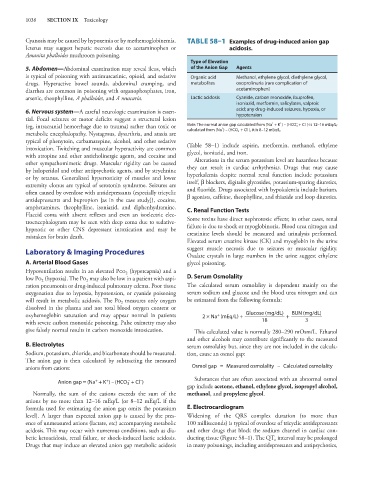Page 1052 - Basic _ Clinical Pharmacology ( PDFDrive )
P. 1052
1038 SECTION IX Toxicology
Cyanosis may be caused by hypoxemia or by methemoglobinemia. TABLE 58–1 Examples of drug-induced anion gap
Icterus may suggest hepatic necrosis due to acetaminophen or acidosis.
Amanita phalloides mushroom poisoning.
Type of Elevation
5. Abdomen—Abdominal examination may reveal ileus, which of the Anion Gap Agents
is typical of poisoning with antimuscarinic, opioid, and sedative Organic acid Methanol, ethylene glycol, diethylene glycol,
drugs. Hyperactive bowel sounds, abdominal cramping, and metabolites oxoprolinuria (rare complication of
diarrhea are common in poisoning with organophosphates, iron, acetaminophen)
arsenic, theophylline, A phalloides, and A muscaria. Lactic acidosis Cyanide, carbon monoxide, ibuprofen,
isoniazid, metformin, salicylates, valproic
6. Nervous system—A careful neurologic examination is essen- acid; any drug-induced seizures, hypoxia, or
hypotension
tial. Focal seizures or motor deficits suggest a structural lesion
+
+
−
−
(eg, intracranial hemorrhage due to trauma) rather than toxic or Note: The normal anion gap calculated from (Na + K ) – (HCO 3 + Cl ) is 12–16 mEq/L;
−
−
+
metabolic encephalopathy. Nystagmus, dysarthria, and ataxia are calculated from (Na ) – (HCO 3 + Cl ), it is 8–12 mEq/L.
typical of phenytoin, carbamazepine, alcohol, and other sedative
intoxication. Twitching and muscular hyperactivity are common (Table 58–1) include aspirin, metformin, methanol, ethylene
with atropine and other anticholinergic agents, and cocaine and glycol, isoniazid, and iron.
other sympathomimetic drugs. Muscular rigidity can be caused Alterations in the serum potassium level are hazardous because
by haloperidol and other antipsychotic agents, and by strychnine they can result in cardiac arrhythmias. Drugs that may cause
or by tetanus. Generalized hypertonicity of muscles and lower hyperkalemia despite normal renal function include potassium
extremity clonus are typical of serotonin syndrome. Seizures are itself, β blockers, digitalis glycosides, potassium-sparing diuretics,
often caused by overdose with antidepressants (especially tricyclic and fluoride. Drugs associated with hypokalemia include barium,
antidepressants and bupropion [as in the case study]), cocaine, β agonists, caffeine, theophylline, and thiazide and loop diuretics.
amphetamines, theophylline, isoniazid, and diphenhydramine. C. Renal Function Tests
Flaccid coma with absent reflexes and even an isoelectric elec-
troencephalogram may be seen with deep coma due to sedative- Some toxins have direct nephrotoxic effects; in other cases, renal
hypnotic or other CNS depressant intoxication and may be failure is due to shock or myoglobinuria. Blood urea nitrogen and
mistaken for brain death. creatinine levels should be measured and urinalysis performed.
Elevated serum creatine kinase (CK) and myoglobin in the urine
Laboratory & Imaging Procedures suggest muscle necrosis due to seizures or muscular rigidity.
Oxalate crystals in large numbers in the urine suggest ethylene
A. Arterial Blood Gases glycol poisoning.
Hypoventilation results in an elevated Pco (hypercapnia) and a
2
low Po (hypoxia). The Po may also be low in a patient with aspi- D. Serum Osmolality
2
2
ration pneumonia or drug-induced pulmonary edema. Poor tissue The calculated serum osmolality is dependent mainly on the
oxygenation due to hypoxia, hypotension, or cyanide poisoning serum sodium and glucose and the blood urea nitrogen and can
will result in metabolic acidosis. The Po measures only oxygen be estimated from the following formula:
2
dissolved in the plasma and not total blood oxygen content or
oxyhemoglobin saturation and may appear normal in patients 2 × Na (mEq/L) + Glucose (mg/dL) + BUN (mg/dL)
+
with severe carbon monoxide poisoning. Pulse oximetry may also 18 3
give falsely normal results in carbon monoxide intoxication. This calculated value is normally 280–290 mOsm/L. Ethanol
and other alcohols may contribute significantly to the measured
B. Electrolytes serum osmolality but, since they are not included in the calcula-
Sodium, potassium, chloride, and bicarbonate should be measured. tion, cause an osmol gap:
The anion gap is then calculated by subtracting the measured
anions from cations: Osmol gap = Measured osmolality – Calculated osmolality
+
+
–
–
Anion gap = (Na + K ) – (HCO + Cl ) Substances that are often associated with an abnormal osmol
3
gap include acetone, ethanol, ethylene glycol, isopropyl alcohol,
Normally, the sum of the cations exceeds the sum of the methanol, and propylene glycol.
anions by no more than 12–16 mEq/L (or 8–12 mEq/L if the
formula used for estimating the anion gap omits the potassium E. Electrocardiogram
level). A larger than expected anion gap is caused by the pres- Widening of the QRS complex duration (to more than
ence of unmeasured anions (lactate, etc) accompanying metabolic 100 milliseconds) is typical of overdose of tricyclic antidepressants
acidosis. This may occur with numerous conditions, such as dia- and other drugs that block the sodium channel in cardiac con-
betic ketoacidosis, renal failure, or shock-induced lactic acidosis. ducting tissue (Figure 58–1). The QT interval may be prolonged
c
Drugs that may induce an elevated anion gap metabolic acidosis in many poisonings, including antidepressants and antipsychotics,

